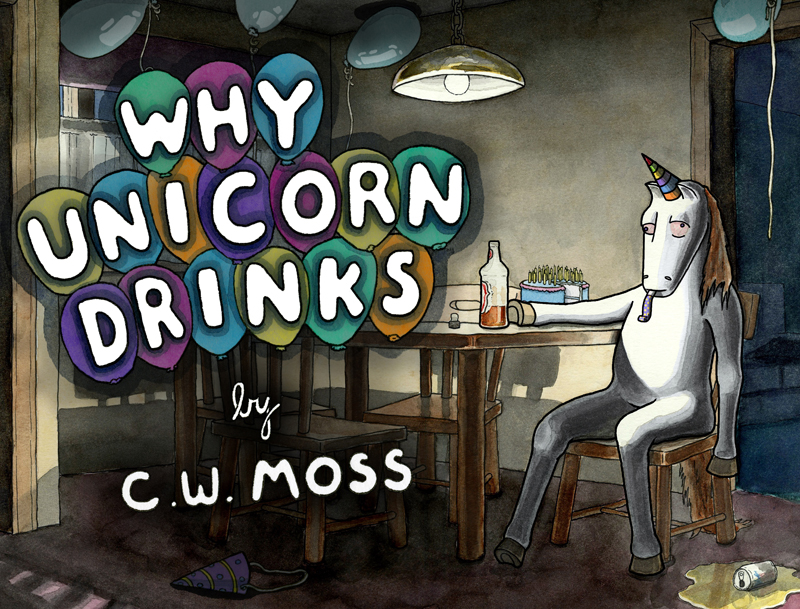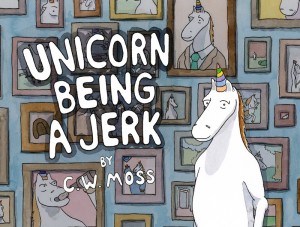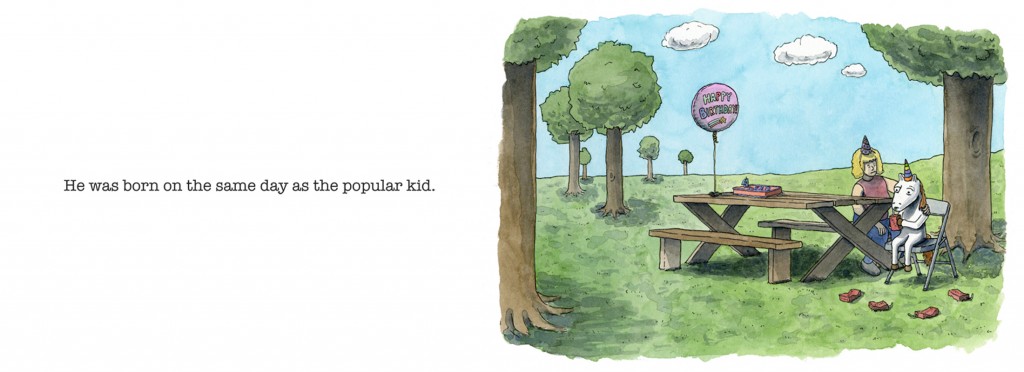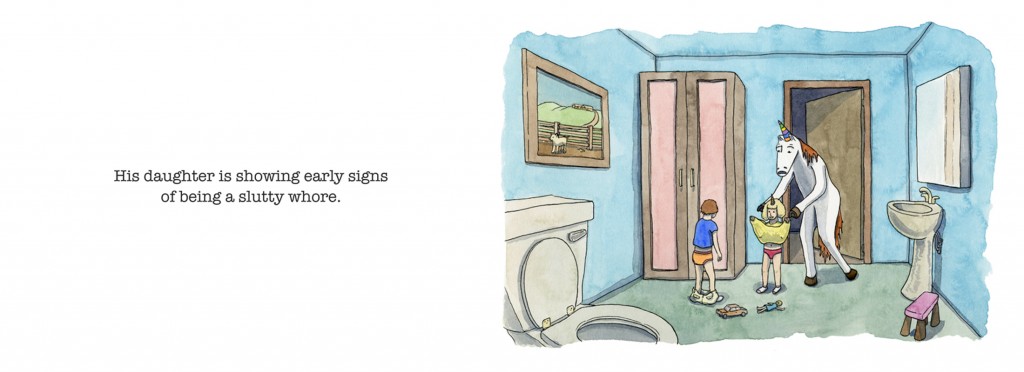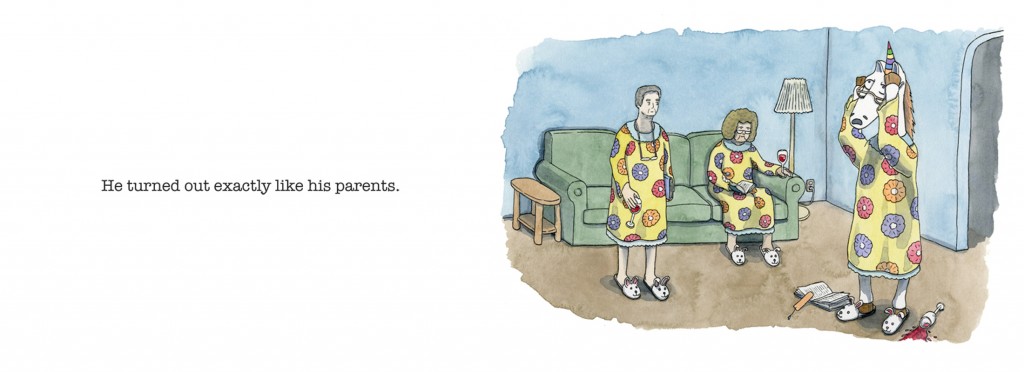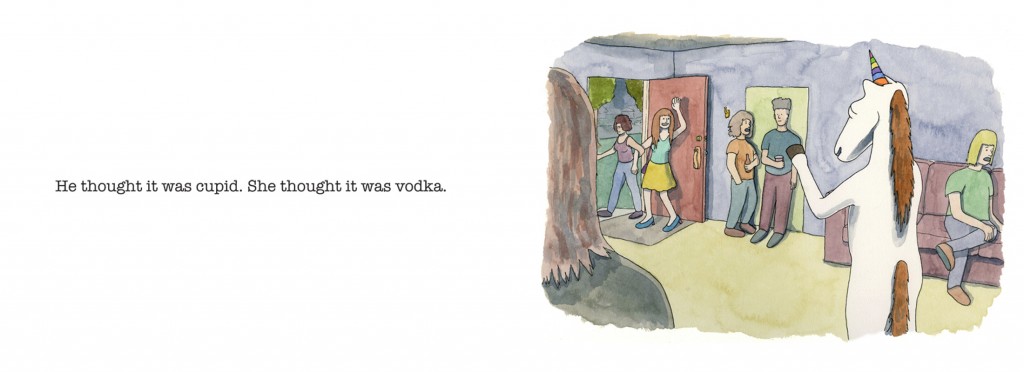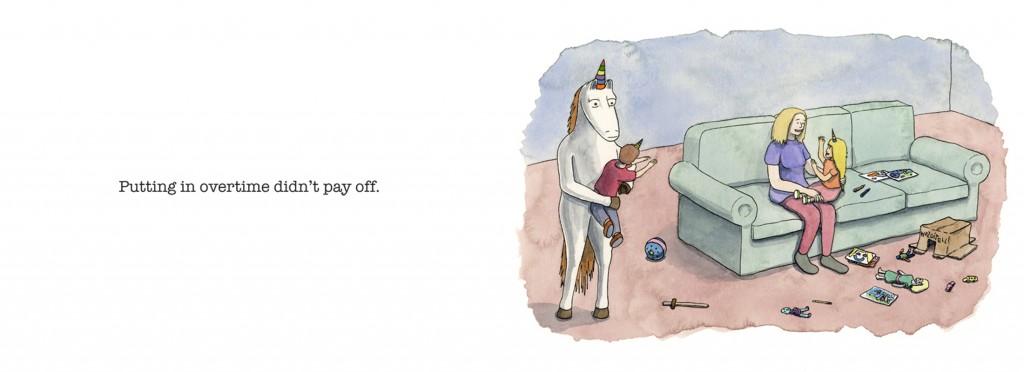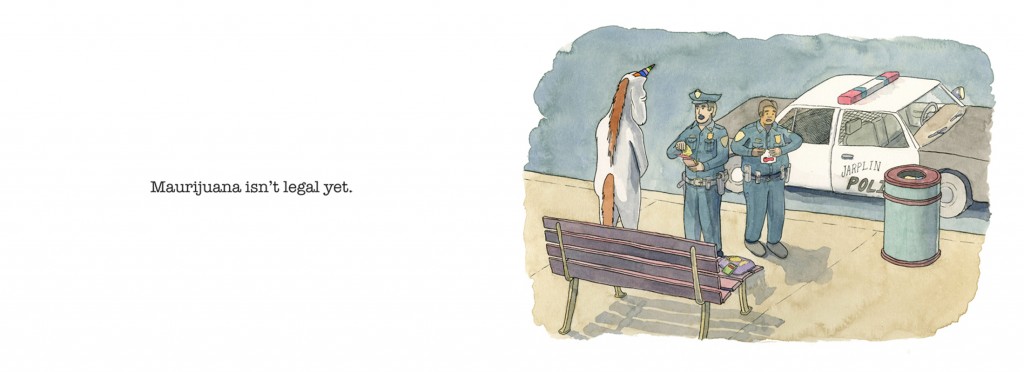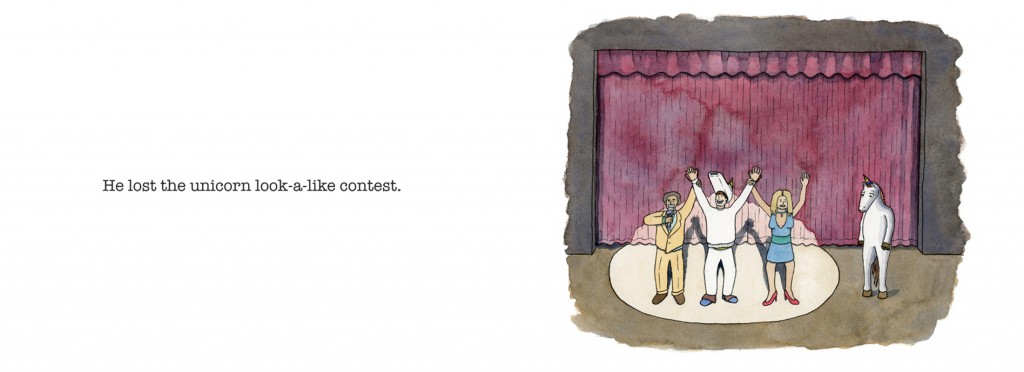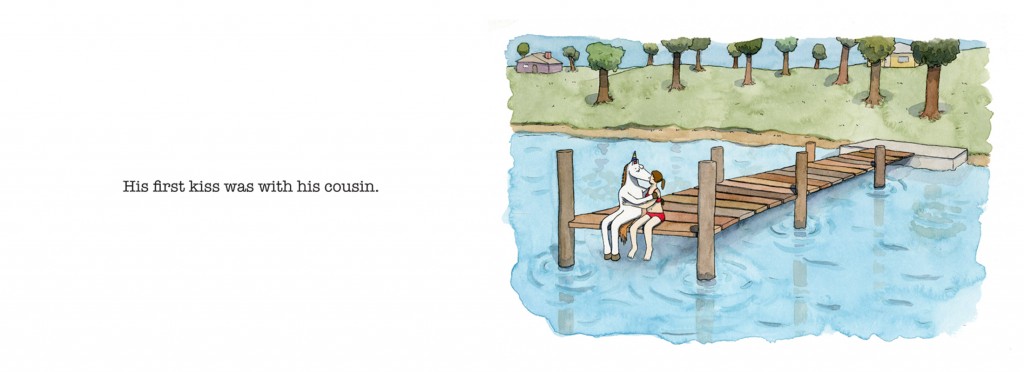C.W. Moss is a rare breed with a bright future. Author and illustrator of the popular Unicorn Being a Jerk is gearing up for the launch of his sequel and anxious to tell Pif all about it. This “maker/doer” (as indicated on his professional business card) hails from our shared hometown of Joplin, MO, but has since relocated to Los Angeles to pursue both educational and artistic endeavors: namely, to receive his B.A. in Graphic Design from Otis College of Art and Design (2011).
Growing up, C.W.‘s artistic inclinations were encouraged by his loving and supportive family. Creativity was in his blood. As a child he always designed the annual Christmas card for his family (a tradition to this day) and constantly attended art classes at the local arts center.
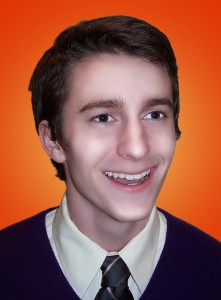 His professional career in the arts began unexpectedly during his first year at Otis College of Art and Design. With a project from his very first illustration course, the preliminary version of his Unicorn series blossomed and began to take form. Positive feedback from friends and classmates encouraged him to run with his idea, and the prototype for Unicorn Being a Jerk was born! This 75-page illustrated book, filled with watercolor images paired with smart, witty, and concise narration about a somehow familiar Unicorn has left us hungry for more! Well dear readers, our prayers have been answered. In 12 short days (February 12th, 2013) the sequel, Why Unicorn Drinks, will be unleashed. This sad, untold story sheds light on what has shaped his character and ultimately turned him to the bottle. A darker, but equally as satisfying adventure. To pre-order click here.
His professional career in the arts began unexpectedly during his first year at Otis College of Art and Design. With a project from his very first illustration course, the preliminary version of his Unicorn series blossomed and began to take form. Positive feedback from friends and classmates encouraged him to run with his idea, and the prototype for Unicorn Being a Jerk was born! This 75-page illustrated book, filled with watercolor images paired with smart, witty, and concise narration about a somehow familiar Unicorn has left us hungry for more! Well dear readers, our prayers have been answered. In 12 short days (February 12th, 2013) the sequel, Why Unicorn Drinks, will be unleashed. This sad, untold story sheds light on what has shaped his character and ultimately turned him to the bottle. A darker, but equally as satisfying adventure. To pre-order click here.
I had the pleasure of meeting up with my good friend C.W. over the Christmas holiday in a small coffee shop on a rainy day. Both sharing an affinity for creativity and produce (a dedicated vegan, he often lusts after my vegetable laden instagram photos), we had a lot of territory to cover. Eventually, we did get down to business. Our discussion below highlights all things Unicorn, future plans, unfinished business, and multiple irons he always seems to have in the fire.
UNICORN AND HOW IT ALL BEGAN:
Emily Frankoski: Where do you come up with ideas and how long does it take you?
C.W. Moss: There’s no set amount; each takes a different amount of time. Unicorn Being a Jerk bloomed out of a shorter book created at school. I had the chance to take a graphic design elective or an illustrated book elective. Due to my interests, the woman who heads the freshmen foundation highly recommended this course to me. I owe a lot to (and dedicated the book to) the man who taught the illustrated book elective, J.T. Steiny. His class sparked this whole idea.
We had to make a 12 page book to be presented at the end of the class. I wrote Unicorn Having Fun, consisting of 12 images. While editing this book, I was able to stockpile so many extra ideas I thought were funny. This book was a lot more generic than ‘being a jerk’ or ‘why someone would drink’, but I recognized a cross-over. For example, one of the scenarios included in Unicorn Having Fun was cross-dressing. And really, that could be included in anything….just like Skydiving (more obvious). What ended up happening was that I generated so much funny material that couldn’t fit under the title of just ‘having fun’.
EF: Hence the creation of Unicorn Being a Jerk?
CW: Yeah, a couple years later I finished Unicorn Being a Jerk. During that whole time I had been taking notes in the back of books and generating more ideas.
EF: How did your idea for Unicorn Being a Jerk happen? How did he go from having fun to being a jerk?
CW: In college there was this sort of phenomenon. I was in a new place, meeting new people and didn’t know anyone. A lot of people were in the same situation, where you start questioning why you believe what you believe. You start playing on your own boundaries. Where before you would never have done something, you find yourself thinking about trying it out just once. Just putting your toe in and seeing what it would feel like. I think a lot of people have regrets from pursuing these whims. Sometimes it was positive (like going out dancing), but a lot of times it would have negative consequences (losing a friend over inappropriate behavior). I started to see this weird, collegiate crisis. I realized a lot of people, and even myself, were doing things we really disliked…even hated. This realization allowed me to start critiquing myself.
EF: So you decided all the things you were contemplating might be categorized as being a jerk?
CW: Sort-of. It was really a self-conscious realization. I may be overly sensitive…everyone has their own moral compass and you can only be guided by so many factors. While struggling with these decisions, I needed some guidance, someone to say “is this really what your gonna be, Cole? Is this how you want to be perceived? Is this how you want to handle things?” Some sort of wake-up call. That I was even questioning doing something that I previously thought wrong was not OK. So I guess, in a way, this book sympathizes with the humanity in all of us. Some of the scenarios in Unicorn Being a Jerk are really extreme, I mean, I definitely don’t or would ever think of clubbing baby seals. But I hope people who look through the book maybe see a little of themselves throughout.
EF: Some scenarios in your books could be offensive. What would you say to that comment?
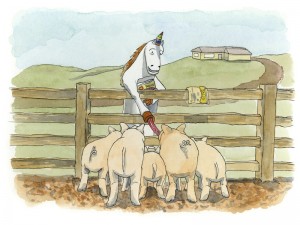 CW: Well, I think offending people is funny. A lot of people are afraid of offensive material, but they shouldn’t be. In the end, you walk away, and that’s the only thing that happens. An issue with me is I don’t really know where the line is? I find the line by doing things and seeing reactions. I often solicit friends for help. I’ll discuss ideas with them in order to figure out how it will fit in with the populace. Without that, I really don’t know. I’m rarely offended by anything.
CW: Well, I think offending people is funny. A lot of people are afraid of offensive material, but they shouldn’t be. In the end, you walk away, and that’s the only thing that happens. An issue with me is I don’t really know where the line is? I find the line by doing things and seeing reactions. I often solicit friends for help. I’ll discuss ideas with them in order to figure out how it will fit in with the populace. Without that, I really don’t know. I’m rarely offended by anything.
EF: What does offend you?
CW: The only stuff that really offends me anymore is intentional malice. That stuff bums me out.
EF: Why is watercolor your medium of choice?
CW: Well, two reasons. Stylistically, because I think it looks like a grandma did it, providing a nice juxtaposition between the more abrasive images and the milder ones. But really, it just suits my personality. I have studied all types of mediums, so it could have been anything. At the time I created Unicorn Having Fun, watercolor was the only medium I knew how to use because that’s what Steiny was teaching. Coincidence, I think not. I like drawing with pens and, more than anything watercolors make me slow down. Consider drawing a car. When you paint with watercolor, you have to paint the car and then literally set it aside to dry. But it generally doesn’t slow me down too much because of how I work. When I watercolored Unicorn Being a Jerk, I watercolored all of them simultaneously. I literally lined up almost 10 tables in a huge room and laid out every board side-by-side. I would go around and just draw green on all of them and keep moving to the next board. This helped allow for appropriate drying time…but then, in this you also risk losing your sanity.
EF: I bet! How long did it take to complete?
CW: Maybe two weekends?
EF: All day?! I hope you listened to music.
CW: Probably. Music is usually the only thing that keeps me sane. But really, insanity kinda helps with stuff like that. I can handle monotonous tasks.
EF: The success of your first book has encouraged you to create a sequel coming out this February 12th. How do you gauge success?
CW: The only form of success I would be looking for, if I was looking for success in writing these, would be in people questioning. But that is hard to measure, you know, the moral compass of someone pre and post reading of the book. That’s the only thing I would ever want to know. Of course book sales allow me to make more books, but it’s a losing game to create something expecting success in return. You should make a project you love and hope everyone else can get something out of it.
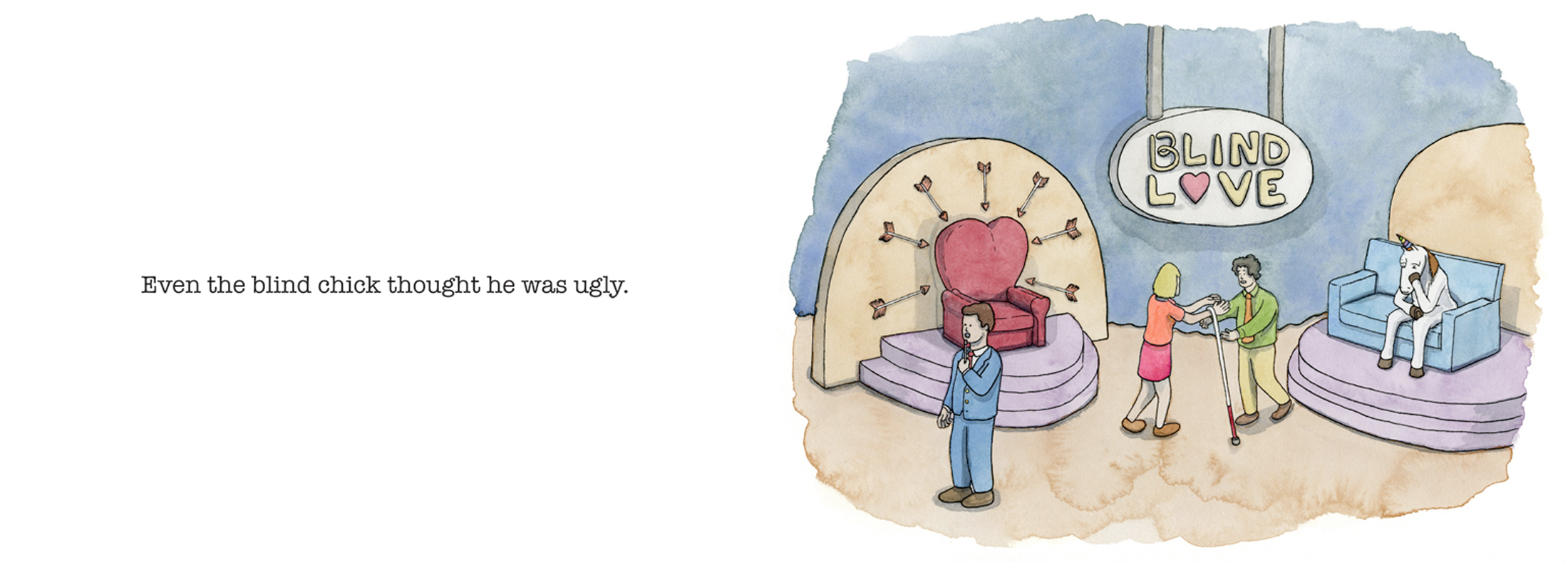 EF: I feel like the sequel, Why Unicorn Drinks, is a bit darker than Unicorn Being a Jerk.
EF: I feel like the sequel, Why Unicorn Drinks, is a bit darker than Unicorn Being a Jerk.
CW: Oh, it’s much darker!
EF: What compelled you to take it in a darker direction?
CW: It’s a mercurial topic to try and talk about why it is what it is. In part, I made it because I laugh the most about real life. There are metaphors throughout my books. For instance, when Unicorn is in the mall with his wife and a cowboy wants to purchase him. It’s really a metaphor that suggests every time you work a job you aren’t really getting paid. Your employer is actually buying part of your life. That’s the point. Hopefully people see these similarities and start making connections. While I approach some issues head-on, there are others I approach with more subtlety. The book is a commentary. It would be impossible for me not to commentate.
Why Unicorn Drinks:
EF: And you’ve been working on this book ever since you finished Unicorn Being a Jerk?
CW: Yeah, I’ve been working on it ever since graduating. This sequel was always in the works, I usually like to work under themes. The new book, Why Unicorn Drinks, didn’t have that title for a really long time. I kind of knew where I was going but I still didn’t know the right banner or umbrella for the contents of the book.
EF: How many Unicorn books do you plan to create?
CW: It’s dangerous to say because I can only continue doing it as long as it goes well and people like it. I’ve been working on the next one for a long time and there are possibly four ideas going right now. I’m not sure what it will be. I have an idea, it just depends on what happens. In the end it is dictated by what I’m going through. I’m always generating ideas. I even wrote a book in between this one and the other about fear. I didn’t know how to write a book about Unicorn and fear, so it became an entirely separate project. You can download the whole thing for free on my website.
It just depends. It helps when I know the title because then I know what I can work under. Sometimes it takes working on something for six months to a year before I feel like I’ve grasped an understanding of how to work it. I don’t want people walking away in confusion. I’m aiming for a healthy balance of the mundane and the absurd.
EF: If you were describing your artistic process to someone, how would you walk them through? What title captures it?
CW: Well, I’ll show you my business card (reads: Maker/doer). Honestly titles scare me. I can tell you about the process I have now. To be honest its kind of hard to remember how I got where I got or did what I did. Everything is an amalgam of everything you’ve done in your life. In some way this interview will have an effect on something I do, it’s just impossible to ignore it’s part of your life. The only way you can form an opinion on something is through action, through living. The next book I’m working on has a much heavier approach on people. It’s specifically about interaction. It’s harder for me to synthesize Why Unicorn Drinks because I’ve been working on it for so long and I honestly can’t remember where the subject actually originated. If you asked me about individual slides, I could probably tell you where that idea came from though.
EF: Why is Unicorn so flawed?
CW: The meta concept behind this, the why to Why Unicorn Drinks, is basically my perception and interpretation of people living their lives. If you meet somebody and they do something mean to you, or they’re a bad person in general, most people never take time to reflect on how they got to that point…like the person who cuts you off on the road, or the person that breaks into your home to steal something. They got there through a specific sequence of actions and upbringing. I felt no one was questioning where those flaws were acquired. It starts somewhere. A person might think some actions are OK because his mother taught him they are OK. Just because he didn’t have the opportunity to learn from the same people you did, doesn’t mean he is an asshole. It just means he didn’t have the same experience. It’s also random to pretend I am this extreme moral compass. That’s just foolish. It’s pure happenstance. So I decided, I’m going to write a book that makes people feel bad about judging Unicorn without wondering where he came from. People kept looking at Unicorn and wondering why he was such a jerk, so I used this book to explain. The stuff included is a little more real. As far as offensive goes, I would say, sure, I think certain parts that could be particularly offensive, because they relate more directly to a person’s own experience. People see themselves in some scenarios so they take more offense.
EF: How did you get your book(s) published?
CW: In the very beginning, I pitched my book to a lot of publishers. But Harper Collins came into my life by chance. They happened to cross my book when everyone happened to cross my book. I spent a summer sending the book to publishers I thought would be perfect for Unicorn. No one took it. I either didn’t hear back or got rejection letters. Which I still have…come on, those are the best part!
EF: How many?
CW: Enough…but not enough to make me give up. One day I was sending off a bunch of emails and demonstrating to my friend how to market her book. I sent off emails to a couple of humor blogs just saying, “hey – you guys might like this – yadda yadda.” I had previously posted almost half the book on my website. I sent them the link and they all pretty much ran it on the same day. At that point it blew up and went viral. It hit Reddit, MetaFilter and other humor websites. From that point on, I had a handful of offers.
DEVELOPMENT AS ARTIST:
EF: Let’s switch gears and discuss your development as artist. When did you start doing art and what influenced your direction?
CW: I sometimes feel I didn’t really have a choice in how I turned out. I believe parents make you into who you become. I have been creating a cover image for my family Christmas card since I was three or four, which definitely contributed to my direction. I was also very involved with taking classes at Spiva (local arts center in Joplin, MO). That’s why I like volunteering and teaching classes there when I’m home. It’s a place that helped shape who I am.
EF: Why did you choose to attend Otis College of Art and Design in Los Angeles?
CW: I actually switched to Otis after a year in Colorado. Originally, I attended the Art Institute of Colorado in Denver. I have no regrets, but decided their technical approach wasn’t what I needed. Otis focused around concept, whereas the Art Institute taught how to use Photoshop, Illustrator, etc.
EF: How were your four years at Otis? What about coursework?
CW: There is a fairly strict regimen at Otis. Luckily, I have always been outwardly passionate. People are pretty aware when I’m really into something. If a class didn’t suit me, I’d pretend the subject was malleable and turn it into something I liked. I’ve always had that approach. It’s not intentional; I often do it accidentally. Sometimes I walked into class with the completely wrong assignment. Thankfully, my teachers were open to that.
Technically, I studied Graphic Design and took illustration courses for fun. To me, illustration was a more natural avenue for expression. Like any school, there was a list of classes you were expected to take and I took most of them. I was lucky to get a terrific mentor who was very involved with scheduling classes. More than anything, she trusted me and my decisions. I had really good grades and wasn’t afraid to tell her I was really interested in a certain course. I would explain I wanted to take a course to use those skills later in life or because that’s where I thought I was going…and she would say OK, sure.
EF: What were you aiming for after Otis and what actually happened?
CW: I had ideas, but learned the hard way early on that you can’t say, “this is exactly what I want to be.” However, you can say, “this is what I think I might be good at” and start exploring that area. I wrote Unicorn Being a Jerk because of positive reactions towards Unicorn Having Fun. Those 12 images had the best response of any project I had done in my life. It was that moment when you realize people really like what you’ve done!
So, I spent the next two weeks doubling the length of the book. In two weeks I did what had previously taken me around 15 weeks! I watercolored the next 12 pages, bound, and took by self-published version around to local independent stores. I asked, “if I published this, would you sell it in your store?” In just the third store, I was offered a publisher for my book. I was blown away! My model of success at that point was to get the book into five local shops, and here I already had one that wanted to publish and distribute it! I was 19 then and nothing has ever felt the way that felt. So I decided to create Unicorn Being a Jerk, working off-and-on throughout the next few years.
EF: Do you foresee creating a book with a different character being a jerk or is jerk exclusively for Unicorn?
CW: You know, jerk ran its course. Unicorn, to a certain degree, represents an obvious part of my personality. But my books are just one of three projects I’m working on.
MASTODON MESA AT THE MELROSE TRADING POST
EF: What else are you working on?
CW: I co-curate Mastodon Mesa, a nomadic performance and installation-based gallery aiming to draw attention and provoke a “what is this?” kind of reaction. It has been around since 2008. Co-founders/co-curators, Mya Stark and Graham Kolbeins, started the gallery in a venue called Pacific Design Center. After it ran its course, they were offered the opportunity to be a part of Melrose Trading Post. I became involved last year. I led a performance. Mya and I got to know each other pretty well, and afterwards she approached me to see if I would be interested in co-curation.
EF: What is Melrose Trading Post?
CW: Melrose Trading Post is a huge flea market at Fairfax High School that happens every Sunday. It’s been going on for at least 20 years. Each Sunday, 5,000 people visit the Melrose Trading Post. They brought Mastodon Mesa in to shake things up a bit. We put on performances and installations intended to encourage questioning and discussion.
EF: So this type of art is more experiential, trying to get a reaction?
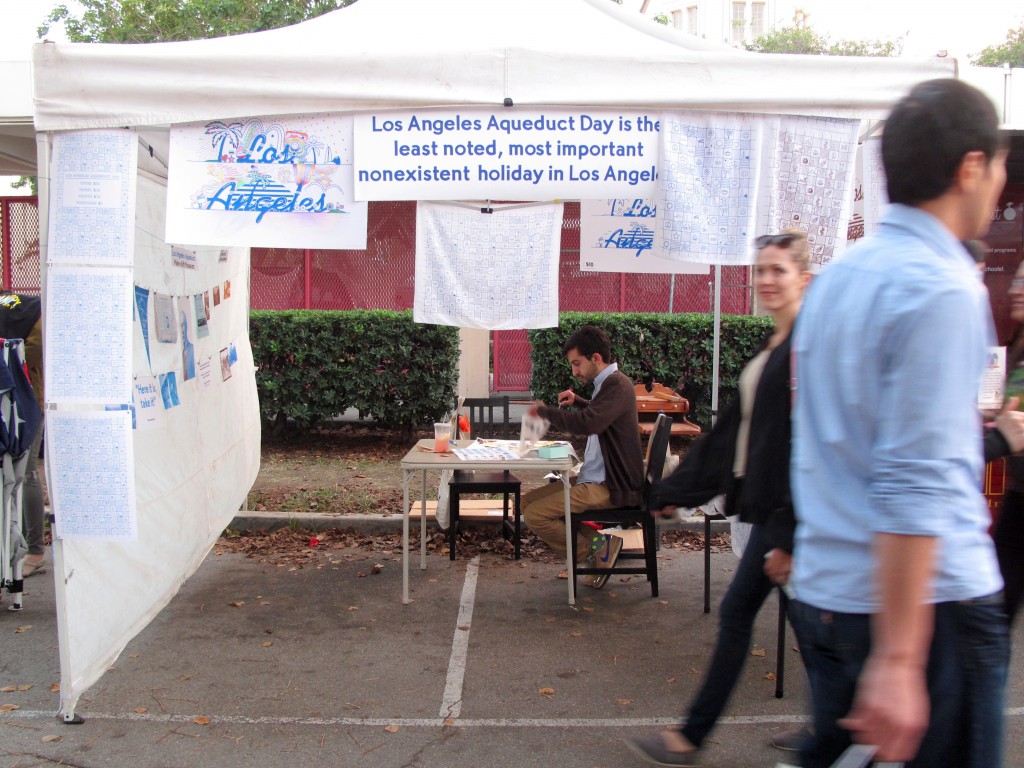 CW: It’s not your typical art gallery. Most people go through typical art galleries passively. Our space is not a typical gallery space. We are in a tent surrounded by a massive amount of people. For that reason we have to calibrate the work we show. It’s challenging and interesting because most artists have never made artwork for this kind of space. Most people don’t do an “interruption” form of art. We aim to catch people off-guard, to show something unique they never would have considered.
CW: It’s not your typical art gallery. Most people go through typical art galleries passively. Our space is not a typical gallery space. We are in a tent surrounded by a massive amount of people. For that reason we have to calibrate the work we show. It’s challenging and interesting because most artists have never made artwork for this kind of space. Most people don’t do an “interruption” form of art. We aim to catch people off-guard, to show something unique they never would have considered.
EF: How does it work? Could you explain an art project you’ve led?
CW: We give each artist a month, so they have four Sundays to do whatever they want. Everyone’s different. Some people do the same thing every Sunday, while others create a narrative arc or do something different each Sunday.
I use the space to test ideas. One week I did this installation/performance called ContraDeath. I wanted people to think about things that really made them happy, but not in some hokey way. I didn’t want to straightforwardly ask them “why are you happy?” Instead, I shaped it into an odd performance where I offered passerby’s the chance to live forever. I presented myself as a global pharmaceutical company representative and all they had to do in order to live forever was to fill out our form. This form was basically the opposite of a suicide note: why you would want to live forever. It’s a very serious decision, someone has to have a good reason to want to live forever. This was a ContraDeath note, a chance to think about everything good in life. I don’t think people do this enough. After the participant had written the contra death note, to make my project more fun and performative, I said, “OK, now you can take this pill that will allow you to live forever. The pill has but one side effect…that you will initially have minty fresh breath.” Then they would take the pill…and live forever.
Another project I led was called Dear God/Satan. People could write a note to either God or Satan, complaining or thanking them for what they’ve been doing. This project aimed to give people a chance to vent about something on their mind. I created a Madlib-style activity, allowing people to take it where they wanted. I chose Madlibs because I wanted people to realize that you can approach serious subjects in an almost trivial way. I mean, it’s goofy! The last time someone did a Madlib was when they were a kid. You can learn about the rest of the shows I’ve led on my website.
EF: Do the artists involved with Mastodon Mesa ever do collaborative shows?
CW: Actually, we just did our first four-person performance show in January, called A Resolution. Each artist presented an interpretive response to the resolutions we feel obligated to make each year.
GRAHAM
EF: You’re creating Unicorn books, co-curating Mastodon Mesa at the Melrose Trading Post, and what’s your third project?
CW: My third project is attempting to start an elderly outreach non-profit called Graham….something I’ve been working on for a few years. In my junior year at Otis, there was a design program where a chosen five students would go on an all expenses paid trip to Holland to study design for ten or eleven days. To be chosen, you had to write a proposal for an organization. I was one of five people chosen! I wrote a proposal for an elderly outreach association, kind of like a Big Brothers Big Sisters, but for the 80+ crowd. Anyone under 80 can volunteer to hang out with anyone over 80. Primarily, it’s about building a community. If you are over 80, more than likely a lot of your friends have past on, and your family might be busy. It’s about connecting people and forming relationships.
Now for the financing side of the organization. If you have been volunteering and meeting with someone for six months to one year, our facilitators would approach you and ask if you felt you knew the person well and could help reiterate why their knowledge is important to share with the world. If they say yes, we would conduct interviews with both the volunteer and their partner. We would discuss the wisdom that has helped them live their life. We would bind this information and create a quarterly or bi-annual periodical to double as a financing tool for the organization and a recruiting manual for future volunteers.
 EF: What’s the story behind naming the organization Graham?
EF: What’s the story behind naming the organization Graham?
CW: I became close to an older man throughout middle school and high school who was maybe 85 when I met him. He past away two years ago, when he was about 93. His name was Lee Graham (left). He was also an artist, always energetic, upbeat, and overall just a really nice guy. He used to come to our family dinners every Sunday. That relationship inspired me and I want to share how important it was to me by helping others connect.
GENERAL QUESTIONS:
EF: What is the best piece of advice you have received?
CW: To never forget everyone is a genius at something.
EF: What is your favorite piece of art/artist?
CW: My favorite thing recently has been Chris Ware’s Building Stories. It’s a nebulous box filled with a magnificent story that can’t seem to remember where anything begins or ends. It’s incredibly moving and unlike anything I’ve seen before.
EF: What is your favorite book/author?
CW: My favorite author and editor is Stuart Bailey. I’ve become completely obsessed with a mercurial project he did called Dot Dot Dot.
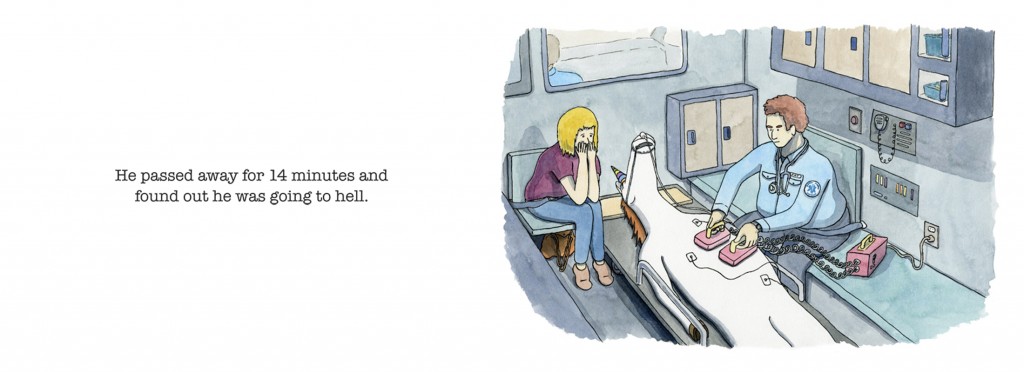 EF: What is the one thing you hope people take away from Why Unicorn Drinks?
EF: What is the one thing you hope people take away from Why Unicorn Drinks?
CW: I hope people understand that Why Unicorn Drinks is a love song.
EF: Who are your biggest inspirations?
CW: Kind of depends on what part of me your talking about. Unicorn-me is Donny Miller or David Shrigley or Chris Ware; the well-paced part of me would say Noam Chomsky, the philanthropic side of me would say Alain de Botton; the purpose part of me would say Seth Godin, and the community part of me would say Jeff Staple. What inspires me most is talking to people I’ve known forever and learning something about them that I’ve never known. I love coming home because the relationship with my parents is constantly shifting and our conversations are always inspiring. Personal-me is inspired by parents, friends…people I talk to everyday.
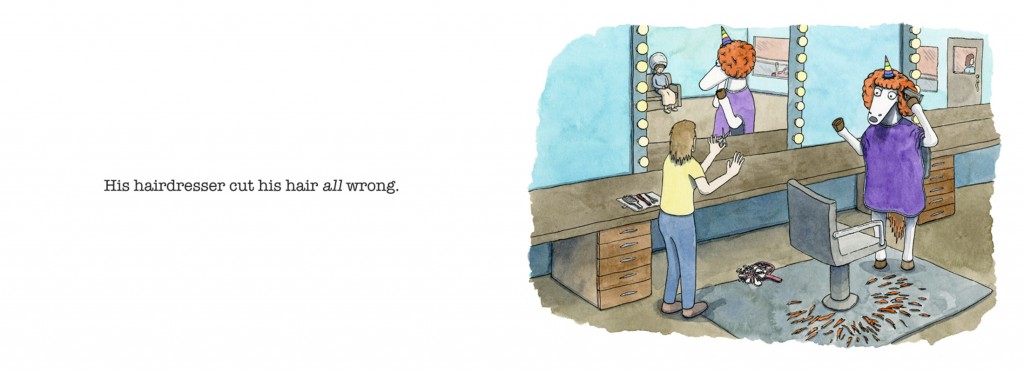 EF: I’ve heard Unicorn has been known to make real-life appearances?
EF: I’ve heard Unicorn has been known to make real-life appearances?
CW: Yeah, I happen to know a Unicorn and sometimes we turn up in the same places. Last I heard he was working out of a movie theatre in Los Angeles but I’m not quite sure what he’s up to now.
EF: How do people keep tabs on him?
CW: You can visit his website, “like” him on facebook, become friends with him on facebook, or follow him on twitter. You should follow him.
EF: Where are your books sold?
CW: To get more information on where my books are sold, visit http://misterunicorn.com.
WANT MORE?
C.W. Moss website: http://www.greyrainbow.com
Unicorn’s official website: http://misterunicorn.com
